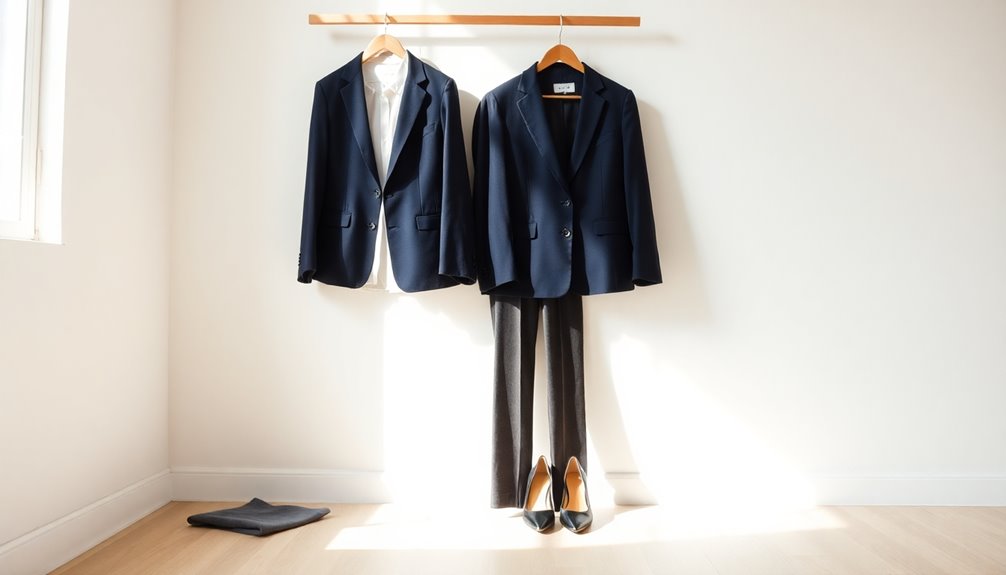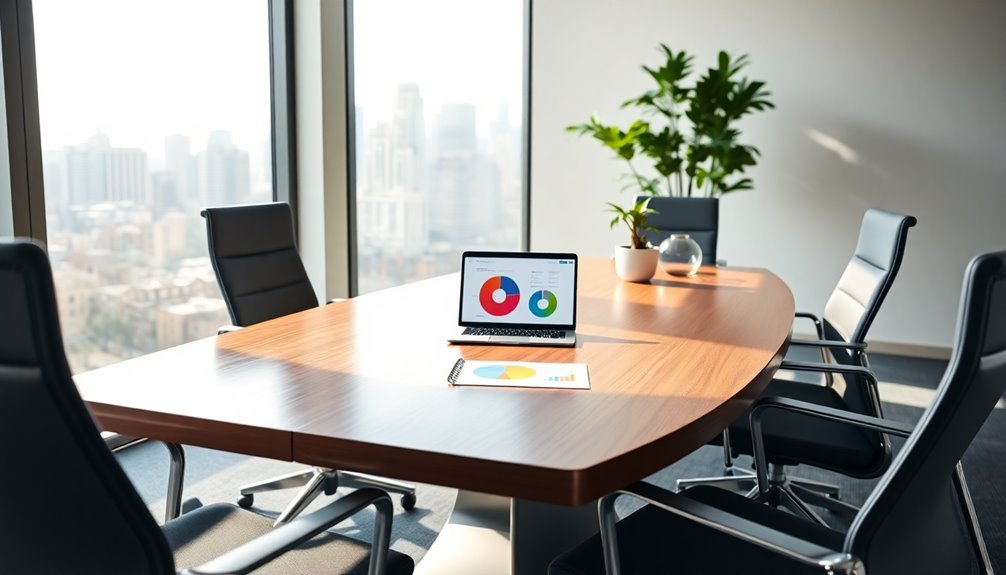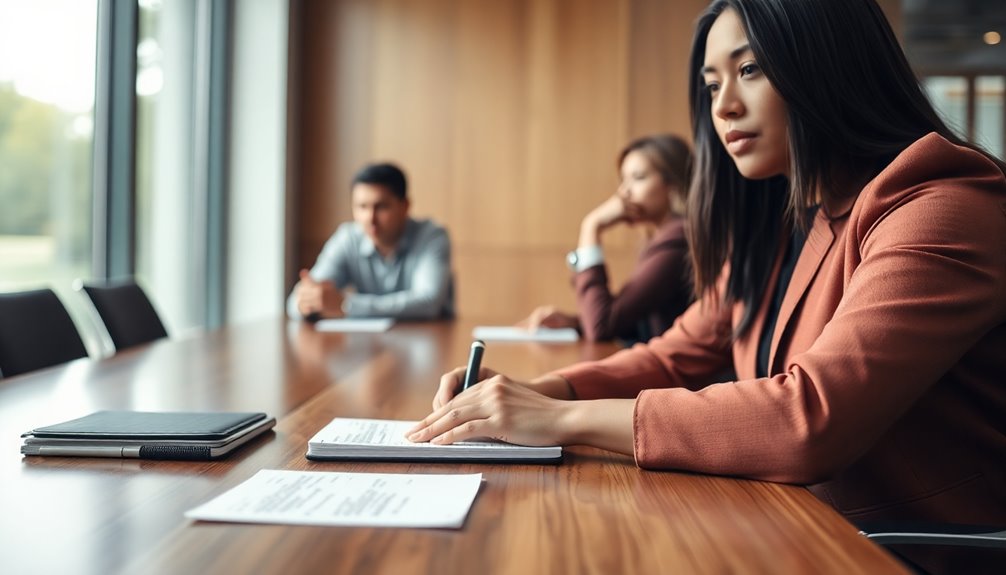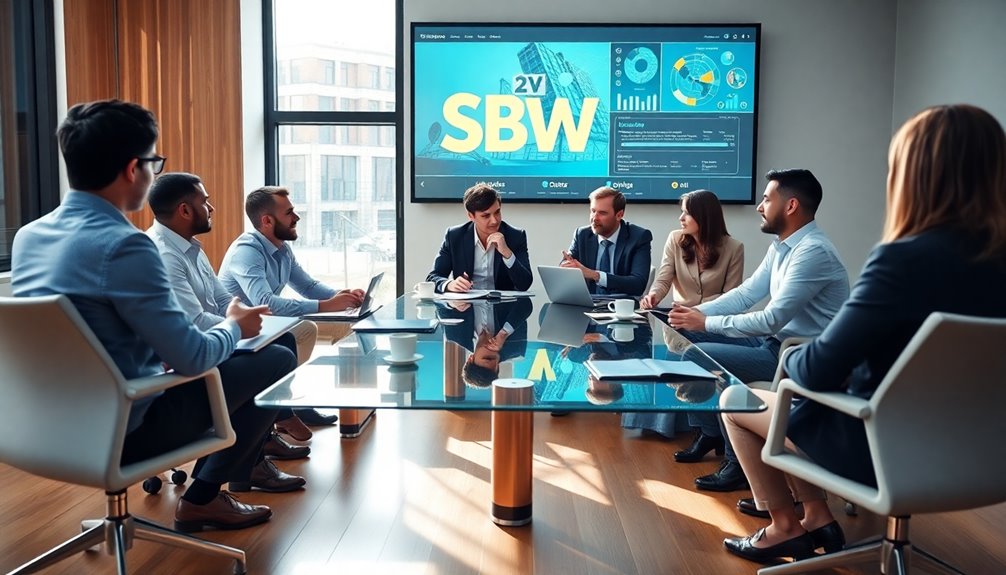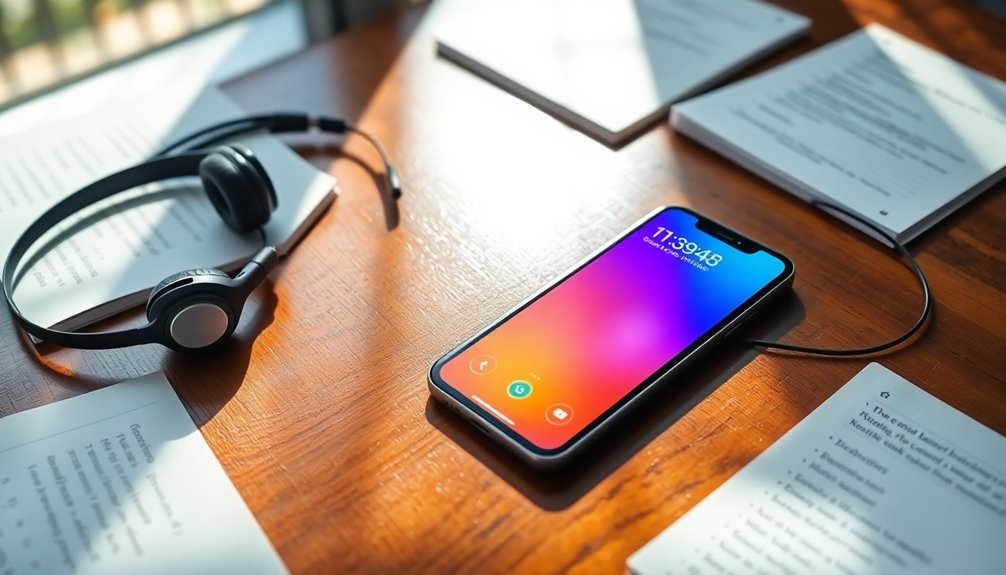Clothes can make or break your interview success, so choose wisely. Dress to reflect respect for the company and alignment with its culture. A well-fitted suit in neutral colors speaks volumes to hiring managers about your professionalism. Men should opt for a tailored suit, crisp shirt, and polished shoes, while women can choose a sharp pant suit or skirt suit with minimal accessories. Remember, confidence shines through a polished appearance. Dressing appropriately not only enhances your chances of making a memorable impression but also boosts your self-esteem. To uncover more tips on acing your interview attire, stick around.
Key Takeaways
- Selecting attire that aligns with the company's culture demonstrates respect and seriousness about the opportunity.
- Well-fitted, high-quality clothing enhances confidence and projects a polished, professional image.
- Neutral colors and classic styles are versatile choices that convey professionalism and reliability.
- Attention to grooming and minimal accessories elevate overall appearance and reflect attention to detail.
- Researching industry-specific dress codes ensures your outfit meets expectations and makes a memorable impression.
Importance of Interview Attire

When you step into an interview, the importance of your attire can't be overstated. Your clothing choices demonstrate respect for the company and the opportunity at hand. A polished, neat appearance shows you take the interview seriously and understand workplace norms.
This initial impression sets the tone for the entire conversation, highlighting your professionalism. Dressing appropriately not only enhances your image but also boosts your confidence. When you look good, you feel good, which positively affects your posture, body language, and overall demeanor. Additionally, being aware of company dress codes ensures that your outfit aligns with the organization's expectations.
It places you in a work frame of mind, even during a telephone interview. Employers value meticulousness and attention to detail, and your attire can signal these traits.
Understanding Industry Standards

When preparing for an interview, understanding industry standards is essential to making a strong impression. Different sectors have specific attire guidelines—what works in finance mightn't fly in a creative field. Knowing these standards helps you choose the right outfit that aligns with the company's culture and expectations. Proper attire not only reflects your respect for the opportunity but also enhances your chances of making a memorable impression.
Importance of Dress Code
A well-defined dress code plays an essential role in shaping the professional image of an organization. When you adhere to industry standards, you promote a consistent and professional company image that enhances trust and confidence with clients and customers.
Your attire reflects the company's culture and values, influencing public perception and supporting brand reputation. Defined dress codes aid in employee identification by customers and the public, further reinforcing the organization's image.
Safety and compliance are also vital. In hazardous work environments, specific attire, such as personal protective equipment (PPE), guarantees safety and meets health regulations. This not only prevents accidents but also reduces the risk of injury from inappropriate clothing.
Moreover, your dress impacts your behavior and performance. Wearing formal attire can boost your confidence and cognitive processing, leading to increased productivity and job satisfaction. It fosters a sense of belonging among employees, minimizing distractions and allowing you to focus on your tasks.
As workplace norms evolve, dress codes must adapt. Clear communication regarding expectations balances professionalism with individual expression.
Industry-Specific Attire Guidelines
Understanding industry-specific attire guidelines is vital for making a lasting impression during interviews. In executive, government, and financial positions, you should wear a well-fitted business suit, complete with a tie and dress shoes in conservative colors like black, navy blue, or grey. Accessories should be minimal yet complementary.
For technology and startup roles, it's important to gauge the company culture. A colored shirt with casual business slacks is often acceptable, but management-level positions typically require a suit and tie. Avoid overly casual items unless specified.
In hospitality, healthcare, and manufacturing, your attire should reflect the company's dress code. Business casual or a suit may be necessary for hospitality, while healthcare attire can vary based on position level. Closed-toe shoes are often recommended for safety in healthcare settings.
For manufacturing, collared shirts and khaki slacks are standard, with suits reserved for management.
Finally, for general trades, restaurant, and casual industries, aim for business casual attire. Clean dress shirts and slacks work well, avoiding jeans and sneakers.
Always verify your clothing is clean and pressed to demonstrate professionalism and respect for the opportunity. Matching the company's dress code can give you an edge.
Key Elements for Men's Attire

Nailing your interview attire is essential for making a strong first impression. For business formal, opt for a well-fitted, two-piece suit in navy, charcoal grey, or black. Pair it with a crisp, white or light blue dress shirt. A conservative tie in a subdued color or pattern will complete the look.
Don't forget polished leather Oxford shoes in good condition, along with a matching leather belt and simple accessories like a watch or cufflinks. Quality garments elevate your overall appearance and make a significant impact during interviews. Incorporating comfortable fabrics can also enhance your confidence throughout the interview process.
If the vibe is business casual, go for dark denim jeans, chinos, or corduroys in good shape. An Oxford shirt, polo, or button-down shirt with a collar works well here. Layer with a cashmere sweater or lightweight blazer for added sophistication.
Choose loafers or polished dress shoes to finish off your outfit.
Regardless of your choice, prioritize quality fabric—think wool or wool blends—and make certain your clothes fit well, allowing for non-restrictive movement. Avoid loud patterns, casual footwear, and worn-out clothes.
Finally, make sure your grooming is on point, with tidy hair and well-groomed facial hair. This attention to detail will help you project professionalism and confidence.
Essential Women's Wardrobe Choices
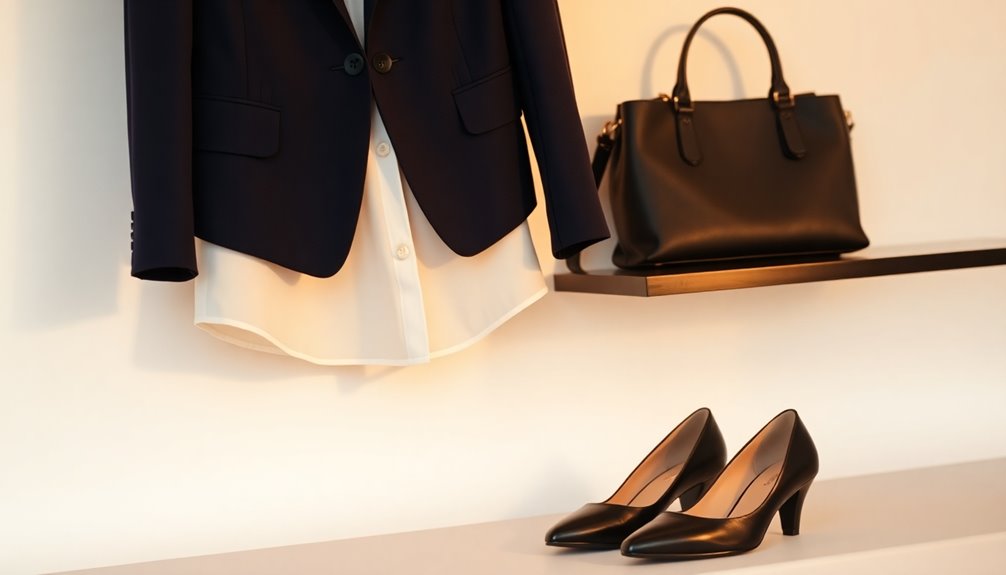
When it comes to choosing the right suit for your interview, you want options that exude professionalism and confidence. Pairing your tailored suit with complementary accessories can elevate your overall look and make a lasting impression. Researching company culture is essential to ensure your attire aligns with the expectations of the workplace. Let's explore the best suit selection tips and accessory guidelines to guarantee you stand out for all the right reasons.
Suit Selection Tips
Choosing the right suit can make all the difference in how you present yourself during an interview. Start by selecting the style that suits you best: pant suits offer comfort and a modern edge, while skirt suits exude feminine professionalism. If you opt for a skirt suit, make certain the skirt hits around knee length for a polished look. Additionally, consider how your retirement planning choices can impact your overall financial confidence, which may influence your interview performance.
Fit is essential; aim for a well-fitted suit with a classic 2 or 3 button jacket. Choose high-quality fabrics like tropical wool or classic wool for a timeless appeal. These options are durable and wrinkle-free, perfect for long interview days. Proper fit is crucial in creating a professional appearance that leaves a lasting impression.
Stick to neutral colors like navy, black, or gray for versatility, and consider subtle patterns like pinstripes for added sophistication.
When it comes to blouses, a crisp white option is always a safe choice. If you're wearing a skirt suit, don't forget nude tights to maintain a professional appearance.
Finally, opt for classic black pumps or conservative shoes that align with the formality of your interview. Prioritize comfort to guarantee you feel confident and composed throughout the process.
Complementary Accessories Guide
A well-curated selection of accessories can elevate your interview outfit and showcase your professionalism.
Start with jewelry—opt for simple, understated pieces. Small pearl or stud earrings and a delicate pendant necklace work well without being distracting. A classic watch with a leather or metallic band adds a touch of sophistication, while it's best to avoid jingly bracelets. Additionally, wearing accessories that are not distracting can help maintain focus during your interview.
When it comes to handbags, choose a leather or leather-like portfolio in neutral tones like black or dark gray. A structured clutch or a versatile crossbody bag can also enhance your polished look. Make sure your bag has enough space for your notepad, pen, and resume. Investing in a well-fitting suit is essential for making a positive impression and pairs perfectly with your chosen accessories.
For footwear, patent black pumps are a timeless choice. If you prefer comfort, low-heeled shoes or sleek leather flats are great alternatives. In creative industries, ankle boots can add a stylish flair.
Lastly, consider additional accessories like a silk scarf or a slim belt to define your waist.
Keep your hairstyle sleek, use understated makeup, and avoid strong perfumes. Together, these choices will help you project confidence and professionalism during your interview.
Business Casual Attire Guidelines

Business casual attire strikes the perfect balance between professionalism and comfort, making it essential for interviews and workplace settings.
When selecting tops, opt for collared shirts, including button-downs and polos, or blouses in simple patterns. Sweaters and cardigans can add layers without compromising style. Chambray shirts are another great choice, provided they fit well and avoid logos.
For bottoms, choose khakis, chinos, or dress pants. Slacks or dark jeans without holes are appropriate, but steer clear of shorts and short skirts. Modest skirts should be knee-length or A-line, and pencil skirts paired with tailored dress slacks work well. Business casual attire varies by industry and company culture, so it's important to consider the environment when selecting your outfit.
Footwear should include closed-toe shoes like loafers, Oxfords, or flats. On "Casual Fridays," you can wear dressy sneakers or fashion boots.
Keep accessories simple with a watch or a ring, and avoid distracting jewelry. Layer with blazers, jackets, or sports coats in neutral colors. Verify everything fits well and looks polished.
Stick to muted colors and subtle patterns to maintain a professional appearance. Remember, the key is to look put-together while feeling comfortable.
Tips for Virtual Interviews
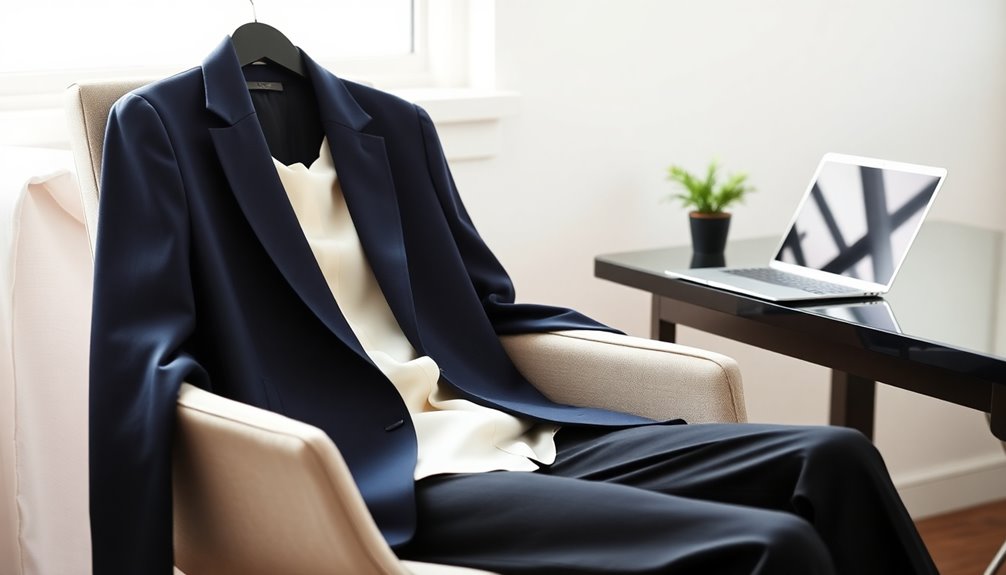
Five key strategies can help you ace your virtual interview. First, preparation is vital. Research the company and role so you're familiar with their expectations. Read all communication from the recruiter thoroughly for any important details.
Next, focus on your setup. Create a clean, uncluttered background and guarantee proper lighting. A speed test can help you gauge your internet stability and avoid technical hiccups. Additionally, ensure that your camera is at eye level for a more engaging visual connection during the interview. Make sure your audio is clear, as a good Wi-Fi signal can significantly improve sound quality.
Also, master the virtual interview platform before the day arrives. Log on early to check your computer, webcam, and audio. Keep your notes and resume handy, but make sure they're out of sight from the interviewer.
To minimize distractions:
- Turn off notifications and switch your phone to silent mode.
- Close unnecessary windows on your screen.
- Keep pets and roommates away during the interview.
- If you need to break eye contact to take notes, consider informing the interviewer.
Lastly, practice effective communication. Rehearse common questions, maintain eye contact, and use hand gestures to convey confidence. By following these strategies, you'll present yourself as a polished candidate ready for success.
Final Thoughts on Attire Choices
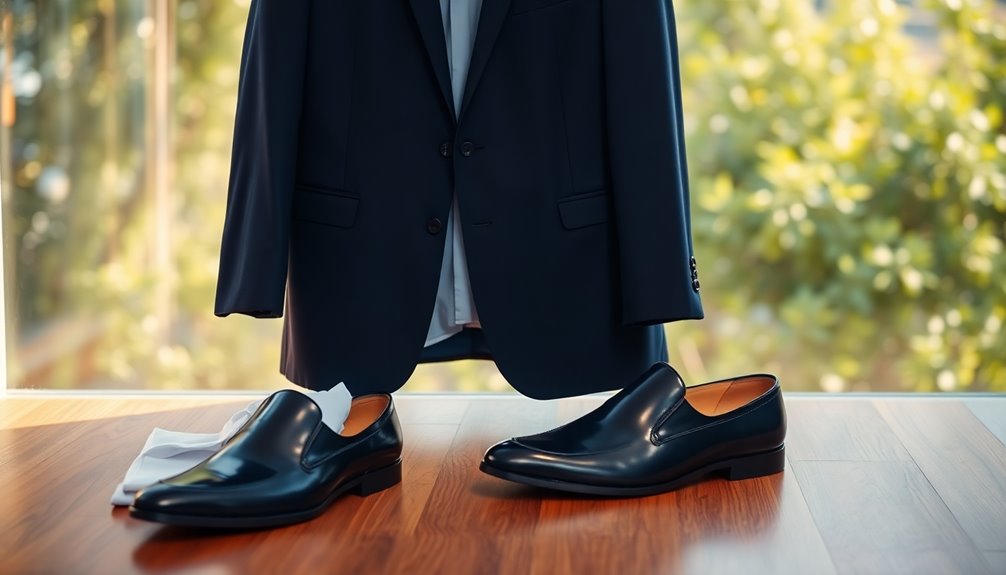
After preparing for your virtual interview, the next step is to contemplate what you'll wear. Understanding the company's culture is crucial in choosing the right attire. Research their dress code—formal suits in navy, black, or grey suit corporate environments, while blazers and dress pants may suit business casual settings.
For creative or tech companies, smart-casual attire like chinos and nice shirts can be appropriate.
For men, a well-fitted single-breasted suit paired with a plain dress shirt and matching tie is ideal. Women should opt for seasonal business suits with tailored skirts or pants and complementary blouses. Always verify your clothes fit well to avoid distractions and enhance your confidence. A professional appearance is essential for transitioning from academia to industry, as it helps convey seriousness about the job.
Grooming matters too; clean and polished shoes, matched with your belt, reflect professionalism. Avoid strong cologne, as you want to keep the focus on your qualifications.
Lastly, aim to dress one step above the company's daily dress code to demonstrate respect and seriousness about the opportunity. By considering these factors, you'll not only look the part but also feel confident, setting the stage for success in your interview.
Frequently Asked Questions
How Can I Accessorize My Interview Outfit Appropriately?
To accessorize your interview outfit appropriately, stick to simple and elegant pieces. Choose classic items like stud earrings or a delicate necklace that complement your attire without overpowering it.
Consider the company culture; traditional firms often prefer conservative jewelry, while creative workplaces may allow for some personal flair.
Make certain everything is clean and in good condition, and avoid flashy items that might distract from your qualifications during the interview.
What Colors Should I Avoid When Dressing for an Interview?
When dressing for an interview, avoid colors like orange, which can seem unprofessional and immature.
Red might convey power, but it can also come off as aggressive, so use it sparingly.
Brown may suggest reliability, but it often appears outdated in creative fields.
Finally, steer clear of multiple colors and loud patterns, as they can distract from your qualifications.
Stick to simple, neutral tones to project professionalism and focus.
Are There Specific Fabrics That Are Best for Interview Clothing?
Yes, specific fabrics can definitely enhance your interview attire.
You'll want to choose breathable materials like cotton or linen for comfort, especially in warmer settings.
Opt for smooth textures like polyester or rayon to maintain a polished look.
Avoid shiny fabrics that can distract from your presence.
How Do Cultural Differences Affect Interview Attire Expectations?
Imagine stepping into an interview, dressed like you just walked off the runway—only to realize you've missed the cultural mark.
Cultural differences greatly affect interview attire expectations. In some regions, conservative clothing is a must, while others lean towards formal business attire.
You should research local customs and dress codes. Adapting your style not only shows respect but also enhances your chance of making a positive impression.
Always dress to align with cultural norms.
What Should I Do if I Don't Own Formal Interview Clothing?
If you don't own formal interview clothing, start by borrowing from friends or family. They might've something suitable that fits well.
Renting is another great option; many services offer stylish attire at affordable prices.
You can also check discount or second-hand stores for professional options.
Keep an eye on sales and clearance sections in your favorite shops to find timeless pieces without breaking the bank.
You've got options to look your best!
Conclusion
In the world of interviews, your attire can speak volumes, just like a well-crafted resume. When you dress thoughtfully, you project confidence and professionalism, making a lasting impression on potential employers. Remember to align your outfit with industry standards and choose pieces that reflect your personal style. Whether it's a sharp suit or polished business casual, your wardrobe is a powerful tool. So, suit up and let your clothes help you open the door to success!
Emmeline is the backbone of our content creation team, bringing complex psychological concepts to life with clarity and empathy. As our Expert Writer, she crafts engaging, insightful articles that guide readers through the intricacies of personality assessments and what they reveal about the human condition. Her passion for psychology and personal development shines through in every piece she writes.
